By Kenneth Richard on 20. February 2017
A Robust Sun-Climate Connection
Increasingly Affirmed By Scientists
“The emerging causal effects from SS [solar activity] to GT [global temperatures], especially for recent decades, are overwhelmingly proved”
— Huang et al., 2017
“Periods with few sunspots are associated with low solar activity and cold climate periods. Periods with many sunspots are associated with high solar activity and warm climate periods. … Studies that employ cosmogenic isotope data and sunspot data indicate that we are currently leaving a grand activity maximum, which began in approximately 1940 and is now declining (Usoskin et al., 2003; Solanki et al., 2004; Abreu et al., 2008). Because grand maxima and minima occur on centennial or millennial timescales, they can only be investigated using proxy data, i.e., solar activity reconstructed from 10Be and 14C time-calibrated data. The conclusion is that the activity level of the Modern Maximum (1940–2000) is a relatively rare event, with the previous similarly high levels of solar activity observed 4 and 8 millennia ago (Usoskin et al., 2003). Nineteen grand maxima have been identified by Usoskin et al. (2007) in an 11,000-yr series.”
Below, the trends in Total Solar Irradiance for 1700-2013, which comes from the Yndestad and Solheim (2017) paper cited above, are shown to closely correspond to the temperature trends for the Northern Hemisphere (NH, derived from “the mean of 22 regional reconstructions of instrumental JJA [June-August] temperatures“) as shown in Stoffel et al., 2015.
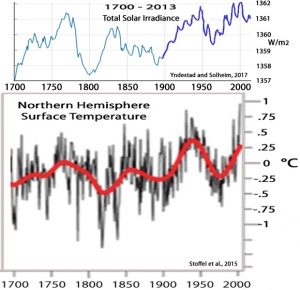
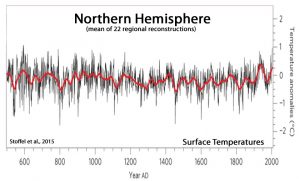
“[T]he recent summer-time warming in Scotland is likely not unique when compared to multi-decadal warm periods observed in the 1300s, 1500s, and 1730s … All six [Northern Hemisphere] records show a warmer interval in the period leading up to the 1950s, although it is less distinct in the CEU reconstruction. [E]xtreme cold (and warm) years observed in NCAIRN appear more related to internal forcing of the summer North Atlantic Oscillation. … There is reasonable agreement in general between the records regarding protracted cold periods which occur during the LIA and specifically around the Maunder solar minimum centred on the second half of the seventeenth century and to some extent also around the latter part of the fifteenth century coinciding with part of the Spörer minimum (Usoskin et al. 2007).”
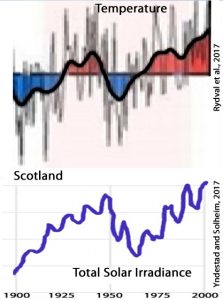 .
. 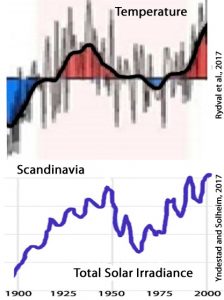
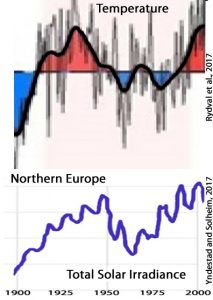
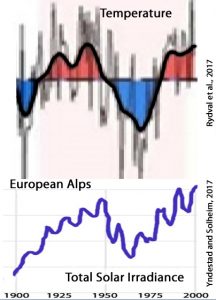
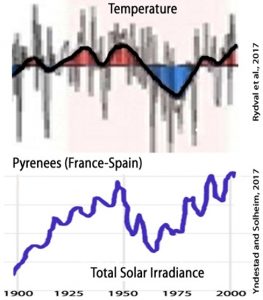
“Various scientific studies have investigated the causal link between solar activity (SS) and the earth’s temperature (GT). [T]he corresponding CCM [Convergent Cross Mapping] results indicate increasing significance of causal effect from SS [solar activity] to GT [global temperature] since 1880 to recent years, which provide solid evidences that may contribute on explaining the escalating global tendency of warming up recent decades. … The connection between solar activity and global warming has been well established in the scientific literature. For example, see references [1–10]. … Among which, the SSA [Singular Spectrum Analysis] trend extraction is identified as the most reliable method for data preprocessing, while CCM [Convergent Cross Mapping] shows outstanding performance among all causality tests adopted. The emerging causal effects from SS [solar activity] to GT [global temperatures], especially for recent decades, are overwhelmingly proved, which reflects the better understanding of the tendency of global warming.”
“Reconstructed long-term temperature variations match reasonably well with solar irradiance changes since warm and cold phases correspond with high and low solar activity, respectively. … The main driver of the large-scale character of the warm and cold episodes may be changes in the solar activity. The beginning of the reconstruction starts with the end of the Spörer minimum. The Maunder minimum, from 1645 to 1715 (Luterbacher et al., 2001) seems to be consistent with a cold period from 1645 to 1706. In addition, the Dalton minimum from 1796 to 1830 is detected for the period 1810 to 1838. However, a considerably cold period from 1778 to 1798 is not in agreement with a decrease in the solar activity. Four warm periods – 1626–1637, 1800–1809, 1845– 1859, and 1986–2012 – have been identified to correspond to increased solar activity.”
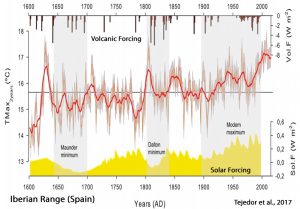
“The SST variation shows a millennial period of ~ 1500-yr and centennial periods of 131-yr and 113-yr. The ~ 1.5 kyr cycle dominated the period of 8.9–5.5 cal. kyr BP, suggesting a tele-connection between the Yellow Sea SST and global climate changes, might through the Kuroshio current. Centennial periods dominated almost all of cold periods recorded in core BY14, implying the signature of solar irradiance cycles by means of the strengthened East Asia Winter Monsoon (EAWM).”
“The results indicate that the climate of the Medieval Climate Anomaly (MCA, AD 900–1300) was similar to that of the Current Warm Period (CWP, AD 1850–present), which contradicts previous studies. … As for the Little Ice Age (LIA, AD 1550–1850), the results from this study, together with previous data from the Makassar Strait, indicate a cold and wet period compared with the CWP and the MCA in the western Pacific. The cold LIA period agrees with the timing of the Maunder sunspot minimum and is therefore associated with low solar activity.”
“The record represents the southernmost annually laminated (i.e., varved) archive from the Balkan Peninsula spanning the Little Ice Age, allowing insights into critical time intervals of climate instability such as during the Maunder and Dalton solar minima. … [W]et conditions in winter prevailed during 1740–1790 AD, whereas dry winters marked the periods 1790–1830 AD (Dalton Minimum) and 1830–1930 AD, the latter being sporadically interrupted by wet winters. … Representing one of the strongest global climate instabilities during the Holocene, the Little Ice Age (LIA) is marked by a multicentennial-long cooling (14the19th centuries AD) that preceded the recent ‘global warming’ of the 20th century. The cooling has been predominantly attributed to reduced solar activity and was particularly pronounced during the 1645-1715 AD and 1790-1830 AD solar minima, which are known as Maunder and Dalton Minima, respectively.”
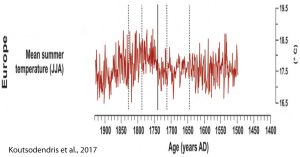
“We suggest that solar activity may play a key role in driving the climatic fluctuations in NC [North China] during the last 22 centuries, with its quasi ∼100, 50, 23, or 22-year periodicity clearly identified in our climatic reconstructions. … It has been widely suggested from both climate modeling and observation data that solar activity plays a key role in driving late Holocene climatic fluctuations by triggering global temperature variability and atmospheric dynamical circulation (e.g., Haigh, 1996; Shindell et al., 1999; Bond et al., 2001; Fleitmann et al., 2003; Dykoski et al., 2005). … The 100, 57 and 23 year periods for PANN [annual precipitation], as well as the 103, 50, and 22 year periods for TANN [annual temperature], correlate well with the 100, 50, 23 and 22 year cycles for the solar activity observed in various solar parameters (e.g., Wilson et al., 1996; Li et al., 1996; Chowdhury et al., 2009; Zhang et al., 2014), therefore implying an in-phase relationship between the climatic oscillation in NC [North China] and solar activity.”
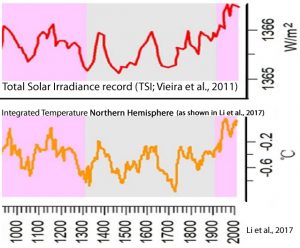
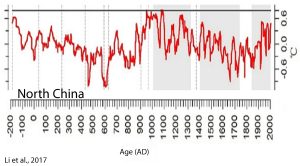
[Reconstructed temperatures for North China show no net warming trend since the mid-20th century.]
“The chironomid-based temperature reconstruction from Lake Atnsjøen in Eastern Norway with mean resolution of 30 years provided evidence that large-scale processes, such as the NAO fluctuations and solar activity modified local climate, and subsequently affected lakes functioning. The three minor cooling periods were reconstructed in the first half of the Millennium: 1050–1150, 1270–1370, 1440–1470 CE, that coincide with solar activity minima: Oort, Wulf, and Spörer respectively. Furthermore, a two peaked cooling period in the second half of the Millennium was identified that coincided with the LIA. These changes co-occurred with the prevailing negative NAO index.”
“The beginning of the 1270–1370 CE cooling coincide with Wulf solar activity minimum suggesting that the climate was responding to Sun activity. The climate cooling synchronous to this solar minimum had almost global range and it has been recorded from Europe, Arctic, North America and Antarctica (Osborn and Briffa, 2006; PAGES 2k Consortium, 2013) but again not in Greenland (Osborn and Briffa, 2006). … The beginning of the 1440–1470 CE cold period is synchronous to the pronounce negative NAO phase (Trouet et al., 2009). … Maunder solar minimum caused a very deep negative NAO index phase (Shindell et al., 2001), which consecutively lead to significant drop in the reconstructed temperature.”
“The temperature reconstruction from Lake Atnsjøen indicates that recent and ongoing climate warming began already in 1800 CE following the LIA. Temperatures increased very fast, from 8.5 to 12.8 °C during the first 75 years [1800-1875], but in the 20th century the increase became less pronounced. … The warming at the beginning of 19th century in the region of Lake Atnsjøen coincides with a reconstruction from Southern Finland (Luoto, 2013), and a record from Northern Sweden (Osborn and Briffa, 2006). Its onset correlates with the positive NAO index and increased solar activity.”
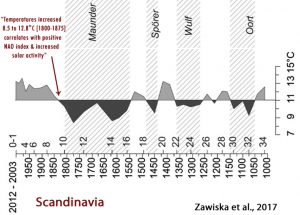
“Late Holocene climate change in coastal East Asia was likely driven by ENSO variation. Our tree pollen index of warmness (TPIW) shows important late Holocene cold events associated with low sunspot periods such as Oort, Wolf, Spörer, and Maunder Minimum. Comparisons among standard Z-scores of filtered TPIW, ΔTSI, and other paleoclimate records from central and northeastern China, off the coast of northern Japan, southern Philippines, and Peru all demonstrate significant relationships [between solar activity and climate]. This suggests that solar activity drove Holocene variations in both East Asian Monsoon (EAM) and El Niño Southern Oscillation (ENSO). In particular, the latter seems to have predominantly controlled the coastal climate of East Asia to the extent that the influence of precession was nearly muted during the late Holocene.”
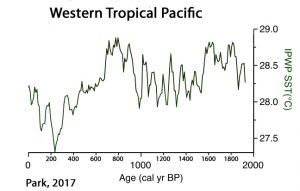
“An increase in atmospheric moisture for the warm period of the year (May–September) since 1890s, and mean annual temperatures since the 1950s was identified. During the same time period [1890s to 2014], there was a marked increase in amplitude of the annual variations for temperature and precipitation. … These [temperature and precipitation] fluctuations are consistent with 10–12-years Schwabe–Wolf, 22-years Hale, and the 32–36-years Bruckner Solar Cycles. There was an additional relationship found between high-frequency (short-period) climate fluctuations, lasting for about three years, and 70–90-years fluctuations of the moisture regime in the study region corresponding to longer cycles. … In the current work, sunspot data were used as a surrogate for solar activity and expressed as the Wolf Number (W). There are several solar cycles which were tested including the Schwabe–Wolf (11 years), Hale (22–24 years), Bruckner (33 years), and Gliessberg (70–90 years) cycles. … This work revealed that there was a correlation between climatic variables and solar activity maxima and minima (W). The hydrothermal coefficient (HTC) has a phase relationship with W, and then both of these variables with the radial increment relative index maxima and minima in Pinus sylvestris L. (I) during the last 100–140 years.”
“A review of the literature indicates that the climate was significantly less stable than previously supposed during the Holocene, since its warming trend was characterized by relevant short-term cooling events occurring at decennial and centennial scale (Dansgaard et al., 1993; Bond et al., 1999; Mayewski et al., 2004). The most recent cold phase was the Little Ice Age (LIA), which caused the expansion of glaciers in the alpine regions at lower latitudes. Several authors have linked this cooler climatic condition to a period of reduced solar activity (Mauquoy et al., 2002), which caused a decrease in summer insolation (Wanner et al., 2011). … [T]he cooling event known as Little Ice Age (LIA)… persisted more or less from the 13th to the 19th century (Perry and Hsu, 2000). … Furthermore, the fluctuations occurring in the frequency curve of H. balthica could be related to several brief cooling events which characterize the LIA, namely Wolf, Sporer, Maunder and Dalton [solar minimum periods] (Lamb, 1984; Mauquoy et al., 2002).”
“Influence of solar variability on the occurrence of Central European weather types from 1763 to 2009 … Weather types and reanalysis data show that the 11-year solar cycle influences the late winter atmospheric circulation over Central Europe with colder (warmer) conditions under low (high) solar activity. Model simulations used for a comparison do not reproduce the imprint of the 11-year solar cycle found in the reanalyses data. … Atmospheric circulation over Europe is strongly correlated to the NAO and hence solar activity is thought to have an influence on weather conditions in Europe in winter. Studies show a preference of cold winters in Europe to be associated with minima in the 11-year solar cycle (e.g., Lockwood et al., 2010; Sirocko et al., 2012). … The 247-year long analysis [1763-2009] of the 11-year solar cycle impact on late winter European weather patterns suggest a reduction in the occurrence of westerly flow types linked to a reduced mean zonal flow under low solar activity. Following these observation, we estimate the probability to have cold conditions in winter over Europe to be higher under low solar activity than under high activity. Also similar [cold] conditions can occur during periods of prolonged reduced total solar irradiance. … Solar activity can have effects on the atmospheric circulation through three different mechanisms. These effects may arise from direct changes in total solar irradiance (TSI), from changes in stratospheric ozone induced by changes in solar UV, or from changes in stratospheric ozone induced by energetic particles, whose flux is modulated by solar activity. The ~1 Wm-2 variation in TSI over an 11-yr sunspot cycle corresponds to a change in the radiation forcing of about ~0.17 Wm-2.”
“Western Mediterranean Holocene record of abrupt hydro-climatic changes … Imprints of North Atlantic meltwater discharges, NAO and solar forcing …Early Holocene winter rain minima are in phase with cooling events and millennial-scale meltwater discharges in the sub-polar North Atlantic. … [A] significant hydro-climatic shift at the end of the African Humid Period (∼5 ka) indicates a change in climate forcing mechanisms. The Late Holocene climate variability in the Middle Atlas features a multi-centennial-scale NAO-type pattern, with Atlantic cooling and Western Mediterranean winter rain maxima generally associated with solar minima.”
“[A]t least six centennial droughts occurred at about 7300, 6300, 5500, 3400, 2500 and 500 cal yr BP. Our findings are generally consistent with other records from the ISM [Indian Summer Monsoon] region, and suggest that the monsoon intensity is primarily controlled by solar irradiance on a centennial time scale. This external forcing may have been amplified by cooling events in the North Atlantic and by ENSO activity in the eastern tropical Pacific, which shifted the ITCZ further southwards. The inconsistency between local rainfall amount in the southeastern margin of the QTP and ISM intensity may also have been the result of the effect of solar activity on the local hydrological cycle on the periphery of the plateau.”
“ENSO is negatively/positively correlated with SSN [sunspot number] when SSN is large/small. … [S]olar activity may take effect on the ENSO, and such an impact should undergo an accumulation procedure (phase delay). XWT also indicates the existence of the impact. It is found that the index is negatively correlated with SSN when SSN is large during a certain long-term interval, and positively when SSN is small. Strong El Niño is inferred to be taken place in decade(s) to come.”
“Abrupt enhancements in the flux of pedogenic magnetite in the stalagmite agree well with the timing of known regional paleofloods and with equatorial El Niño−Southern Oscillation (ENSO) patterns, documenting the occurrence of ENSO-related storms in the Holocene. Spectral power analyses reveal that the storms occur on a significant 500-y cycle, coincident with periodic solar activity and ENSO variance, showing that reinforced (subdued) storms in central China correspond to reduced (increased) solar activity and amplified (damped) ENSO. Thus, the magnetic minerals in speleothem HS4 preserve a record of the cyclic storms controlled by the coupled atmosphere−oceanic circulation driven by solar activity.”
“The time series of sunspot number and the precipitation in the north-central China (108° ∼ 115° E, 33° ∼ 41° N) over the past 500 years (1470–2002) are investigated, through periodicity analysis, cross wavelet transform and ensemble empirical mode decomposition analysis. The results are as follows: the solar activity periods are determined in the precipitation time series of weak statistical significance, but are found in decomposed components of the series with statistically significance; the Quasi Biennial Oscillation (QBO) is determined to significantly exist in the time series, and its action on precipitation is opposite to the solar activity; the sun is inferred to act on precipitation in two ways, with one lagging the other by half of the solar activity period.”
“[W]e investigate the impact of internal climate variability and external climate forcings on ISMR on decadal to multi-decadal timescales over the past 400 years. The results show that AMO, PDO, and Total Solar Irradiance (TSI) play a considerable role in controlling the wet and dry decades of ISMR [Indian summer monsoon rainfall]. Resembling observational findings most of the dry decades of ISMR occur during a negative phase of AMO and a simultaneous positive phase of PDO.”
“In this paper, the authors investigate a particular feature, the ocean heat content (OHC) anomaly, in different phases of the total solar irradiance (TSI) cycle. The results show that almost opposite spatial patterns appear in the tropical Pacific during the ascending and declining phases of the TSI cycle. Further analysis reveals the presence of the quasi-decadal (~11-year) solar signal in the SST [sea surface temperature], OHC [ocean heat content] and surface zonal wind anomaly field over the tropical Pacific with a high level of statistical confidence (>95%). … In Misios and Schmidt (2012), the ensemble simulations from an AOGCM showed that the tropical SST oscillates almost in-phase with the 11-year solar cycle. White and Liu (2008) also found the fluctuation of the upper ocean warming to be in-phase with TSI [total solar irradiance] on the decadal scale during the twentieth century, governed by a resonant excitation of the tropical delay action oscillator and solar forcing, and the warming stage lagged the solar peak year by one to three years. … [P]atterns of OHC and potential temperature anomalies in the tropical Pacific are quite spatially symmetric in the ascending and declining phases, which seems phase-locked with the phases of the TSI cycle. The most significant regions of the OHC anomaly are locate just in the high correlation areas (beyond the 95% confidence level), which are ‘solar-sensitive’ regions with a clear quasi-11-year period.”
Increased Surface Solar Radiation (Via Reduced Cloud Cover) Explains Post-1980s Warming
“Trends of all-sky downward surface solar radiation (SSR) from satellite-derived data over Europe (1983–2010) are first presented. The results show a widespread (i.e., non-local dimension) increase in the major part of Europe, especially since the mid-1990s in the central and northern areas and in springtime. There is a mean increase of SSR of at least 2 W m− 2 per decade from 1983 to 2010 over the whole Europe, which, taking into account that the satellite-derived product lacks of aerosol variations, can be mostly related to a decrease in the cloud radiative effects over Europe. … Downward surface solar radiation (SSR) is a critical part of the Global Energy Balance and the climate system … A widespread decrease of SSR from the 1950s to the 1980s [when global cooling occurred] has been observed (Liepert, 2002; Stanhill and Cohen, 2001; Wild, 2009), followed by an increase of SSR since the mid-1980s [coincident with global warming]… Pinker et al. (2005) used a different product (2.5° resolution) and found that the derived global mean SSR series underwent a significant increase of 1.6 W m−2 per decade from 1983 to 2001. … On the other hand, Hatzianastassiou et al. (2005) derived a SSR product from 1984 to 2000 (2.5° resolution) and reported a significant increase of +2.4 W m−2 per decade in the global mean series, which is considerably higher than the results from Pinker et al. (2005) and Hinkelman et al. (2009).”
“From the 1950s to the 1980s, a decline in the intensity of solar radiation was observed (Stanhill and Cohen 2001; Liepert 2002). This phenomenon was dubbed “global dimming”. Later research demonstrated that from the mid-1980s onwards, an increase in solar radiation followed, which was referred to as “global brightening” (Wild et al. 2005; Pinker et al. 2005). Reasons for shifts in radiation trends have not been fully determined; these may result from changes in atmospheric transparency caused by variations in cloud cover or concentrations of anthropogenic aerosols (Wild 2009). … An important work that covered as many as 237 stations grouped into the five climatic regions and concerned, inter alia, sunshine duration trends from 1961 to 2004 in six South American countries, was published by Raichijk (2012). The results of that study confirm downward trends in sunshine duration from the 1950s until the 1980s and upward ones since the beginning of the 1990s, which were also observed in other regions of the world. Satellite short-wave radiation data spanning the period from 1984 to 2005 confirm the results obtained at ground sunshine duration measurement stations in all five climatic regions of South America. Upward sunshine duration trends are associated with an increase in the intensity of solar radiation and a decrease in cloud cover (Raichijk 2012). It should be stressed that both insolation and cloud cover are primarily related to atmospheric circulation and are influenced by heat balance and local conditions (Dubicka and Limanówka 1994).”
Posted in Solar, Solar Sciences |


















[…] Publishing Headlines: A Robust Sun-Climate Connection Increasingly Affirmed By […]
Dr Willie Soon recently gave a talk where he covered the solar impact. It is covered in this article. The video is a must watch video, it is educational, entertaining and empowering.
Climate “Science” on Trial; Cherry Picking Locations to Manufacture Warming
https://co2islife.wordpress.com/2017/02/18/a-tale-of-two-cities-cherry-picking-locations-to-manufacture-warming/
The problem with all these research papers is that no one knows what temperature to use. The ground measurements are garbage, and the Satellite data is too short a time period. The other problem is that it isn’t the solar output, it is the radiation that reaches the earth’s surface. Using ground measurements doesn’t really measure the impact of CO2, it measures the impact of incoming radiation reaching and warming the earth. IMHO, the best measurement for incoming solar radiance is simply the temperature of the oceans…adjusted for El Ninos and El Ninas. Oceans are warmed by incoming radiation, not IR back radiation.
Smoking Gun #7: Antarctica isn’t warming, but the Oceans are
https://co2islife.wordpress.com/2017/01/16/climate-science-on-trial-the-forensic-files-exhibit-g/
I believe this to be the best explanation so far:
http://joannenova.com.au/2015/01/is-the-sun-driving-ozone-and-changing-the-climate/
Kenneth –
No doubt you’ll be accused of cherry-picking. But that’s a mighty fine orchard you have there, sir.
Like CO2,the sunspot connection is not directly the cause of temperature changes but the AGENT that causes changes. Moreover, both act within an environment that has warming and cooling elements. We’d do best to determine how much the solar influence has, rather than pit a unique or supremely dominant solar cause against the IPCC unique or supremely dominant CO2 cause.
I just finished this an article that shows how to use this data in a court case against the climate alarmists.
Climate “Science” on Trial; The Criminal Case Against the Alarmists
https://co2islife.wordpress.com/2017/02/21/climate-science-on-trial-the-criminal-case-against-the-alarmists/
[…] […]
[…] addition to the more than 20 new scientific papers affirming a robust connection between solar forcing and climate already published in 2017, there are another new 20 scientific papers that indicate natural […]
[…] Link: https://notrickszone.com/2017/02/20/20-new-scientific-papers-link-modern-climate-trends-to-solar-forc… […]